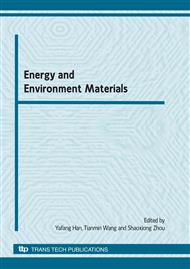[1]
KALIFA P. et al.: Spalling and pore pressure in HPC at high temperatures. Cement and Concrete Research, 30(1) (2000) 1915-(1927).
DOI: 10.1016/s0008-8846(00)00384-7
Google Scholar
[2]
DING Y. et al.: The Investigation on Strength and Flexural Toughness of Fibre Cocktail Reinforced Self-Consolidating High Performance Concrete, Construction and Building Materials, available online 4 March (2008).
DOI: 10.1016/j.conbuildmat.2007.11.006
Google Scholar
[3]
DONG X.: Research on Mechanical Properties and Spalling Behaviours of FRHPC Subjected to High Temperature and Fire, Ph.D. Dissertation (in Chinese), Dalian University of Technology, (2006).
Google Scholar
[4]
LAU A., ANSON M.: Effect of high temperatures on high performance steel fibre reinforced concrete, Cement and Concrete Research, 36 (9) (2006) 1698-1707.
DOI: 10.1016/j.cemconres.2006.03.024
Google Scholar
[5]
GIACCIO M. and ZERBINO L.: Mechanical behaviour of thermally damaged high-strength steel fibre reinforced concrete, Materials and Structures 38 (2005) 335-342.
DOI: 10.1007/bf02479299
Google Scholar
[6]
DONG X. and DING Y.: Mechanical properties of SFHPC after high temperatures, Journal of Southwest Jiaotong University (English Edition), 15 (1) (2007) 12-19.
Google Scholar
[7]
KALIFA P. et al.: High-temperature behaviour of HPC with polypropylene fibres from spalling to microstructure. Cement and Concrete Research, 31 (10) (2001) 1487-1499.
DOI: 10.1016/s0008-8846(01)00596-8
Google Scholar
[8]
HERTZ D.: Limits of Spalling of Fire-exposed Concrete. Fire Safety Journal, 38 (2) (2003) 103-116.
DOI: 10.1016/s0379-7112(02)00051-6
Google Scholar
[9]
CHAN Y N et al: Compressive strength and pore structure of high-performance concrete after exposure to high temperature up to 800 o C. Cement and Concrete Research, 30 (2) (2000) 247-251.
DOI: 10.1016/s0008-8846(99)00240-9
Google Scholar
[10]
ZOLLO R. F. Fiber-reinforced Concrete: an Overview after 30 Years of Development. Cement and Concrete Composites, 19 (2) (1997) 107-122.
DOI: 10.1016/s0958-9465(96)00046-7
Google Scholar
[11]
XIAO J, KOENIG G.: Study on Concrete at High Temperature in China-an Overview. Fire Safety Journal, 39 (2004) 89-103.
Google Scholar
[12]
WU B. et al: Effect of High Temperature on Residual Mechanical Properties of Confined and Unconfined High-Strength Concrete. ACI Materials Journal, 99 (4) (2002) 399-407.
DOI: 10.14359/12223
Google Scholar
[13]
ZHANG B. et al: Relationship between Brittleness and Moisture Loss of Concrete Exposed to High Temperatures. Cement and Concrete Research, 32 (3) (2002) 363-371.
DOI: 10.1016/s0008-8846(01)00684-6
Google Scholar
[14]
RILEM TC 162-TDF: Test and Design Methods for Steel Fiber Reinforced Concrete - BENDING TEST. Materials and structure, 35 (2002) 579-582.
DOI: 10.1617/13884
Google Scholar
[15]
CHEN B, LIU J Y. Residual strength of hrbrid-fiber-reinforced high-strength concrete after exposure to high temperatures. Cement and Concrete Research, 30 (6) (2004) 1065-1069.
DOI: 10.1016/j.cemconres.2003.11.010
Google Scholar
[16]
KODUR R. and SULTAN A.: Effect of temperature on thermal properties of high-strength concrete. Journal of Materials in Civil Engineering, ASCE, 2003, 15(2): 101-107.
DOI: 10.1061/(asce)0899-1561(2003)15:2(101)
Google Scholar
[17]
DING Y. et al: The Investigation on the workability of fibre cocktail reinforced Self-Consolidating High Performance Concrete, Construction and Building Materials, available online December (2007).
DOI: 10.1016/j.conbuildmat.2007.03.034
Google Scholar
[18]
DING Y. et al: Investigation of the stress and strain state of clay pipes under firee condition, Ceramics International, accepted date: 20-9-(2007).
Google Scholar
[19]
WANG Y.: Study on High Temperature Behaviours of FRHPC Pipe Members, Ph.D. Dissertation (in Chinese), Dalian University of Technology, (2008).
Google Scholar
[20]
DING, Y. and KUSTERLE, W.: Compressive stress-strain-relationship of steel fibre reinforced concrete at early age, Cement and Concrete Research, 30 (10) (2000) 1573-1579.
DOI: 10.1016/s0008-8846(00)00348-3
Google Scholar
[21]
DING Y., Kusterle, W.: Comparative study between Steel Fibre Reinforced Concrete and Steel Mesh Reinforced Concrete at early ages in the panel tests. Cement and Concrete Research, 29 (1999) 1827-1834.
DOI: 10.1016/s0008-8846(99)00177-5
Google Scholar
[22]
CHIAIA B. et al: Evaluation of minimum reinforcement ratio in FRC members and application to tunnel linings, Materials and Structures (2007) 40: 593-604.
DOI: 10.1617/s11527-006-9166-0
Google Scholar
[23]
RILEM Draft Recommendation TC50-FCM: Determination of Fracture Energy of Mortar and Concrete by Means of Three Point Bend Tests on Notched Beams. Materials and Structures, 1985, 18 (106): 285-290.
DOI: 10.1007/bf02498757
Google Scholar
[24]
GUO Zhenhai.: Mechanic behaviour of concrete materials and elements under normal and high temperature (in Chinese), ISBN: 730212109, Tsinhua University, 2006-6-1.
Google Scholar
[25]
NEVILLE A. M.: Properties of Concrete, ISBN 0-582-23070-5, pp.359-3390, Longman Group Limited, (1995).
Google Scholar


